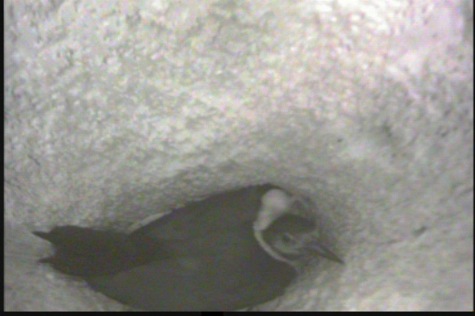
Lewis's Woodpecker Research Grabs Headlines
Block title
 By: Kate StoneM.S. Avian Scientist
By: Kate StoneM.S. Avian ScientistMany pairs of Lewis's woodpeckers call the MPG Ranch home. Lewis's woodpeckers are unusual in the woodpecker world. They feed on flying insects instead of drilling into wood for food. They also eat available fruits like hawthorn berries, serviceberries, and elderberries. Lewis's woodpeckers have an unusual coloration. Their plumage combines dark green back feathers with rosy-pink breast and face feathers. To find Lewis's woodpeckers, look for a large, dark bird fly-catching from snags along the river.
Lewis's woodpeckers rely on large snags to house their cavity nests. Right now, most of the nests on the MPG Ranch have fledged their young. Family groups stay close to the nest snag for a few days, and the young loudly beg for food. They take advantage of the floodplain dragonflies and fruits before their migration in late August.
Megan Fylling, a graduate student at the University of Montana, monitors the Lewis's woodpecker nests on the ranch and other areas throughout the Bitterroot and Clark Fork River watersheds. This Ravalli Republic article highlights her research.

An adult Lewis's woodpecker and recently hatched young reside in a cottonwood cavity. Male and female Lewis’s woodpeckers are identical, and both incubate eggs. So we do not know if this is mom or dad on the nest.

Three days later, three featherless young huddle in the nest. Despite their youth, these nestlings already make plenty of noise begging for food.

About the AuthorKate Stone
Kate graduated from Middlebury College with a B.A. in Environmental Studies and Conservation Biology in 2000. She pursued a M.S. in Forestry at the University of Montana where her thesis focused on the habitat associations of snowshoe hares on U.S. National Forest land in Western Montana. After completing her M.S. degree in 2003, Kate alternated between various field biology jobs in the summer and writing for the U.S. Forest Service in the winter. Her fieldwork included projects on small mammal response to weed invasions, the response of bird communities to bark beetle outbreaks and targeted surveys for species of concern like the black-backed woodpecker and the Northern goshawk. Writing topics ranged from the ecology and management of western larch to the impacts of fuels reduction on riparian areas.
Kate coordinates bird-related research at the MPG Ranch. She is involved in both original research and facilitating the use of the Ranch as a study site for outside researchers. Additionally, Kate is the field trip coordinator and website manager for the Bitterroot Audubon Society. She also enjoys gardening and biking in her spare time.
Kate coordinates bird-related research at the MPG Ranch. She is involved in both original research and facilitating the use of the Ranch as a study site for outside researchers. Additionally, Kate is the field trip coordinator and website manager for the Bitterroot Audubon Society. She also enjoys gardening and biking in her spare time.



















